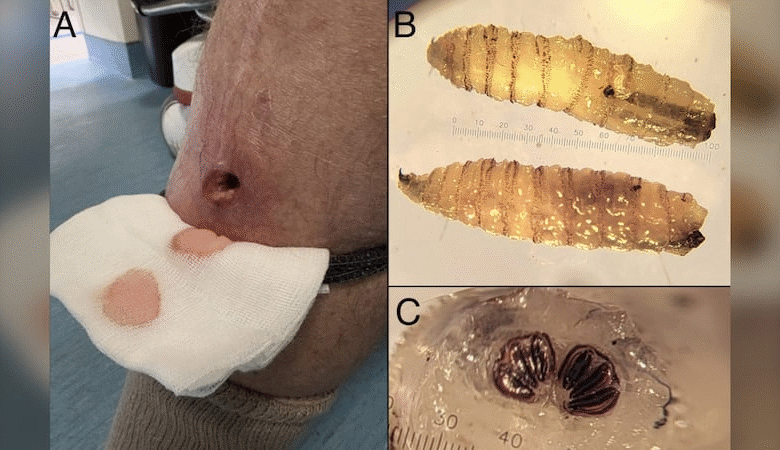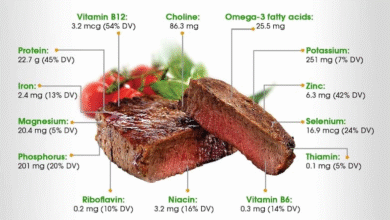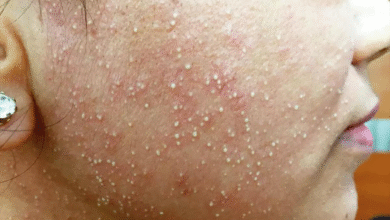Screwworm Infection Reported in Maryland: What You Need to Know

Screwworm infection is a serious concern that emerged recently with the identification of a travel-related case in Maryland. A patient who had recently visited El Salvador—a nation grappling with a significant screwworm outbreak—was diagnosed by the Centers for Disease Control and Prevention (CDC). This condition, known medically as myiasis, results from fly larvae, particularly the New World screwworm, feeding on the living tissues of hosts. The CDC has emphasized that while this infection poses a low risk to public health in the United States, swift identification and treatment are crucial to prevent severe outcomes. As awareness grows, understanding the implications of a screwworm infection, especially for travelers, becomes increasingly important.
The occurrence of screwworm infection, also characterized as a parasitic disease, highlights the risks associated with myiasis—an infestation caused by fly larvae. This condition, prevalent in certain tropical regions, can adversely affect both humans and animals, particularly livestock such as cattle, sheep, and goats. Given recent reports of a New World screwworm case linked to travel, health officials are urging vigilance among individuals returning from areas where these pests flourish. Preventive measures and awareness about the signs of myiasis can aid in timely treatment and reduce the potential for outbreaks. These developments underscore the need for continued public health monitoring to mitigate the effects of this emerging threat.
Understanding Screwworm Infection and Its Impact
Screwworm infection, scientifically termed myiasis, occurs when the larvae of the New World screwworm fly infest living tissues, creating painful lesions and potential severe health risks. Recently, the first case of a travel-related human screwworm infection in the United States was confirmed in Maryland, following the patient’s travel to El Salvador. This incident has raised significant public health concerns, especially since screwworm outbreaks can escalate rapidly if not contained. The Centers for Disease Control and Prevention (CDC) has been working closely with local health authorities to investigate the implications of this case and ensure swift response measures.
Healthcare professionals highlight that the transmission of screwworms can occur when female flies lay eggs on open wounds, particularly in tropical regions. The larvae then hatch and begin to feed on the host’s living tissues, potentially leading to fatal outcomes if not treated in time. The risks associated with myiasis extend beyond human health; livestock such as cattle, sheep, and goats, are particularly susceptible, posing a threat to the agricultural economy if a screwworm outbreak were to occur.
The Rise of Myiasis Cases in the U.S.
Despite being rare, instances of myiasis have been increasingly reported in the United States, particularly in those who travel to endemic areas where the New World screwworm is prevalent. The recent case in Maryland highlights a troubling trend where travel-related infections can introduce new parasitic threats into the country. According to the CDC, these infections are more common in tropical regions, leading health officials to monitor travel patterns and educate the public about potential risks. Even though the risk to public health is currently considered low, vigilance is necessary, especially with increasing global travel.
As travel resumes post-pandemic, public health authorities are becoming more aware of such risks. The CDC advises travelers to take precautions, such as avoiding areas where screwworms are known to be prevalent and ensuring proper wound care to avoid attracting fly infestations. Understanding the symptoms of myiasis and seeking immediate medical assistance can prevent severe complications related to this parasitic infection, ensuring traveler safety.
CDC’s Response to Screwworm Infection Cases
The Centers for Disease Control and Prevention (CDC) has an essential role in managing the potential spread of screwworm infections across the United States. Following the confirmation of the first travel-related case in Maryland, the CDC collaborated with state health departments to conduct a thorough investigation. This collaboration aims to assess the risk factors associated with the case and implement preventive measures that can reduce the chances of further infections. Implementing surveillance systems and public health alerts helps keep communities informed while providing guidelines for maintaining safety.
In addition to monitoring human cases, the CDC also focuses on livestock, which can be severely affected by screwworm infestations. Ensuring livestock health is crucial not only for animal welfare but also for the economic stability of agriculture. With estimates suggesting that a screwworm outbreak could lead to extensive financial losses in the livestock sector, the CDC’s proactive strategy aims at preventing widespread infestation through public education and effective control measures.
Prevention and Awareness of Screwworm Outbreaks
Awareness and prevention are key to combating the spread of screwworm infections, particularly for travelers heading to regions experiencing active outbreaks. Public health entities underscore the importance of practical precautions, such as avoiding contact with poorly maintained animals and being cautious with any wounds. Additionally, travelers are urged to practice good hygiene and seek medical attention promptly if any unusual symptoms arise post-travel. By staying informed and vigilant, the potential risk of encountering screwworm infestation can be significantly lowered.
Furthermore, educating livestock owners about the signs and symptoms of screwworm infestations in animals can lead to quicker interventions. Training programs and resources provided by agencies like the CDC and USDA can equip farmers with necessary knowledge to protect their herds. The establishment of sterile fly production facilities, as announced by the USDA, represents proactive efforts to combat potential screwworm outbreaks and safeguard agricultural health.
Exploring the Economic Impacts of Screwworm Outbreaks
The economic implications of a screwworm outbreak in livestock can be staggering, with estimated costs reaching up to $1.8 billion due to livestock death, treatment, and prevention measures. Such losses significantly impact farmers and the broader agricultural economy. The recent alerts about cases in Maryland serve as a reminder of the importance of maintaining surveillance and readiness to address any outbreaks swiftly. The potential for economic ramifications amplifies the necessity for ongoing research and resource allocation to safeguard agriculture from myiasis and its consequences.
In regions heavily reliant on livestock, investment in prevention and research can mitigate the disruptions caused by screwworm infestations. Strategic planning that includes public health guidelines, effective pest control measures, and farmer education can form a robust framework to combat these parasitic infections. By fostering collaborations between agricultural and health sectors, communities can work together to limit the financial impacts of screwworm outbreaks and promote sustainable farming practices.
Traveling Safely: Avoiding Screwworm Infection
As the world becomes increasingly interconnected, travelers must prioritize safety when heading to regions where screwworm infections might be prevalent. Personal precautions such as keeping wounds clean and covered, staying away from areas with known infestations, and maintaining good hygiene can significantly reduce the risk of contracting myiasis. Engaging with local health advisories and adhering to travel recommendations can also serve as vital steps in preventing exposure to this parasitic infection.
Furthermore, understanding the signs and symptoms of screwworm infection allows travelers to seek immediate medical attention if they suspect they may have been exposed. This awareness is essential in mitigating severe health consequences associated with untreated myiasis. In addition to personal responsibility, health officials play a crucial role in providing timely information and guidelines that can help travelers stay informed and safe during their journeys.
The Role of Agriculture in Managing Screwworm Risks
Agriculture plays a pivotal role in both the spread and management of screwworm infections, particularly in livestock-intensive regions. With animals being highly susceptible to screwworm infestations, the agricultural sector must remain vigilant against such threats. By implementing biosecurity measures, farmers can minimize risks posed by screwworms and others parasites, ensuring the health of their livestock and protecting economic stability within the industry.
Education and awareness initiatives focusing on prevention—such as proper animal care, regular health checks, and reporting unusual symptoms—empower farmers to act quickly in the event of a suspected outbreak. Collaborations between veterinary services, public health bodies, and farmers are essential in fostering an environment of safety that can help thwart the inevitable challenges posed by screwworm infestations.
Historical Perspectives on Screwworm Outbreaks
Understanding the historical context of screwworm outbreaks highlights their impact on public health and agriculture. The New World screwworm was once a significant threat to livestock in the United States, leading to severe economic losses. Historical data illustrates the challenges posed by infestations and the concerted efforts taken by organizations like the CDC and USDA to eradicate the problem. Lessons learned from past outbreaks underscore the importance of surveillance systems and rapid response protocols in managing current risks.
Additionally, historical insights reveal how agricultural practices and public health policies have evolved in response to the threat of screwworm infestations. The establishment of programs aimed at sterilizing male flies, which effectively reduced populations, showcases successful strategies that could be revisited in current scenarios. By studying past responses, health officials and farmers can develop better strategies to address and prevent future screwworm outbreaks.
Global Perspectives on Screwworm Management
The presence of screwworm infections is not limited to the United States; various countries globally face similar threats, particularly in tropical regions. International public health collaborations underline the complexity of managing screwworm infestations, as migration and travel can easily introduce these parasitic infections to new environments. Global perspectives emphasize the importance of sharing knowledge, strategies, and resources to effectively deal with outbreaks wherever they may arise.
Moreover, countries experiencing chronic issues with screwworms can benefit from the implementation of sustainable pest control measures. These may include community education, active monitoring, and the application of innovative technologies for managing fly populations. Coordinated efforts on a global scale create opportunities for learning from one another, ultimately leading to better management outcomes and reduced risks associated with myiasis and its impact on health and agriculture.
Frequently Asked Questions
What is a screwworm infection and how does it relate to myiasis?
A screwworm infection, also known as myiasis, is a parasitic infestation caused by the larvae of certain fly species that feed on living tissue. This infection occurs when female flies deposit their eggs on or near a person’s wound, nose, or ears, leading to an infection characterized by swelling and tissue damage.
What should I know about the recent screwworm outbreak reported in Maryland?
The recent travel-related screwworm infection in Maryland was confirmed after an individual returning from El Salvador, where a screwworm outbreak is ongoing, presented symptoms. The CDC has confirmed that while this introduction poses a low risk to public health in the U.S., awareness and caution are advised for travelers.
How does one contract a screwworm infection during travel?
A screwworm infection often occurs when individuals travel to areas experiencing outbreaks, such as tropical regions. Travelers may contract myiasis if female flies lay eggs on their wounds or if the larvae spread through contact with infected insects like ticks and mosquitoes.
What are the symptoms of a New World screwworm infection?
Symptoms of a New World screwworm infection include the emergence of swellings or lumps at the site of infection as the larvae feed on living tissue. Prompt medical attention is critical, as untreated infections can lead to severe tissue damage or fatality.
Are livestock at risk for screwworm infection, and what economic impact does it have?
Yes, livestock such as cattle, sheep, and goats are highly susceptible to screwworm infections. An outbreak can have significant economic consequences, with estimates suggesting potential costs up to $1.8 billion in livestock losses and management expenses.
What precautions can travelers take to avoid screwworm infections?
Travelers should take precautions such as avoiding contact with areas where flies may deposit their eggs, keeping wounds clean and covered, and seeking immediate medical attention if any signs of infection, such as swelling or unusual lumps, appear.
How is the CDC involved in managing screwworm infections in the U.S.?
The CDC plays a crucial role in monitoring and investigating screwworm infections in the U.S., collaborating with state health departments to confirm cases and assess public health risks. Their focus is on prevention and response strategies to control potential outbreaks.
Is myiasis commonly found in the U.S. compared to tropical regions?
Myiasis is not commonly found in the U.S.; most cases occur in tropical regions where conditions favor screwworm infections. The CDC reports that individuals traveling to these areas are at greater risk for contracting a screwworm infection.
| Key Point | Details |
|---|---|
| First Travel-related Case | A human screwworm infection confirmed in Maryland from a patient who traveled to El Salvador. |
| CDC’s Role | The CDC is working with Maryland health officials to investigate the infection. |
| Screwworm Overview | Screwworm, or myiasis, is caused by fly larvae that feed on living flesh. |
| Transmission | Larvae infect humans through eggs deposited near wounds or on animals that carry them. |
| Health Risks | Myiasis can lead to serious health issues and can be fatal if untreated. |
| Livestock Threat | Cattle, sheep, and goats are particularly affected, posing an economic threat. |
| Future Measures | The USDA plans to establish a sterile fly facility in Texas to prevent outbreaks. |
| Economic Impact | Texas could face $1.8 billion in costs from a screwworm outbreak. |
Summary
Screwworm infection has become a concern in the United States with the recent identification of a travel-related case in Maryland. This parasitic disease, caused by the larvae of the New World screwworm, poses significant health risks and can be fatal if not treated promptly. Individuals are at risk, especially after traveling to tropical areas where myiasis is more prevalent. With livestock being highly susceptible to this condition, the economic impact could be severe, leading to substantial costs if not managed effectively. It is crucial for health authorities to monitor and mitigate the risks associated with screwworm infections to protect public health.




